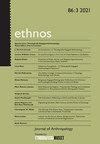媒介、对象和西喜马拉雅地区的存在问题
IF 1
3区 社会学
Q2 ANTHROPOLOGY
引用次数: 0
摘要
在某些宗教背景下,主要是基督教新教,人类学家经常与困扰信徒的存在问题作斗争——上帝同时存在和不存在。然而,在西喜马拉雅的印度教中,存在的问题是完全不同的。这个地区的王室神灵深深地存在,体现在灵媒和轿子上。因此,这些神的追随者不会对一个缺席的神的概念感到困惑。相反,他们需要在一个上帝非常有形的世界中航行,以一种可能导致不适和焦虑的方式。在这篇文章中,我展示了灵媒和轿子在宗教体验中的不同角色,以及轿子如何被认为是更可靠的神的表现。我认为这是由于当地人需要与灵媒保持一定程度的距离,以避免神灵的过度存在。关键词:宗教调解;怀疑神的存在;印度教;西喜马拉雅披露声明作者未报告潜在的利益冲突。注1 Mahasu是Botha、Bashik、Pabasi和Chalda四兄弟的合称。在讨论中,四兄弟的追随者通常以单数形式提到马哈苏,有时指所有的马哈苏兄弟,但在其他时候,就像在这种情况下,他们只指一个兄弟,通常是Botha.2恩格尔克(Citation2007: 9)将存在的问题定义如下:“一个宗教主体如何通过在某些话语、行动和物体中投入权威和意义来定义和声称建立与神的关系”这篇文章是基于我从2013年到现在断断续续从事的西喜马拉雅地区的实地考察,特别是喜马偕尔邦的上西姆拉和北阿坎德邦的西北部。数十位皇家神灵居住在这个地方。在我的现场最著名的是Mahasu兄弟虽然人们可以在印度教背景下找到主权神灵(Singh Citation2015;Maunaguru Citation2020),西喜马拉雅山脉的王室神灵以深刻的方式存在于他们的追随者的生活中,主要是通过他们从一个地方移动到另一个地方的能力在喜马拉雅山脉西部和中部的一些地区,女神可以被视为皇室,拥有自己的领土和轿子(例如Halperin Citation2019;Sax Citation1991)。6Sutherland (Citation2003)描述了三种类型的节日游行活动,其中神灵彼此见面参见萨克斯(引文2003)关于两个神之间竞争的例子,表现为神反对敌对神的轿子进入他们的领土萨克斯(Citation2003: 183)描述了一个不常见的情况,两个神有相同的名字,Jakh,他们不仅被认为是独立的神,而且他们之间甚至有冲突。本研究由以色列科学基金会资助:[批准号1212/21]。本文章由计算机程序翻译,如有差异,请以英文原文为准。
Mediums, Objects, and the Problem of Presence in the Western Himalayas
ABSTRACTIn some religious contexts, mainly Protestant Christianity, anthropologists often contend with the problem of presence that preoccupies believers – the simultaneous presence and absence of God. However, in the Hinduism of the Western Himalayas the problem of presence is quite different. The royal deities in this region are profoundly present, embodied in mediums and palanquins. Thus, followers of these deities are not puzzled by the concept of an absent god. Instead, they need to navigate in a world where gods are very tangible, in ways that can cause discomfort and anxiety. In this article I demonstrate the different roles of mediums and palanquins in the religious experience, and how palanquins are considered more reliable manifestations of the deities. I suggest that this is due to the need of the locals to maintain some degree of distance from the spirit mediumship in order to avoid excess presence of the deities.KEYWORDS: Religious mediationdoubtpresence of deitiesHinduismWestern Himalayas Disclosure StatementNo potential conflict of interest was reported by the author(s).Notes1 Mahasu is a joint name for four brothers: Botha, Bashik, Pabasi, and Chalda. In discussion, followers of the four brothers usually refer to Mahasu in the singular, sometimes indicating all four Mahasu brothers but at other times, as in this case, they are referring only to one brother, usually Botha.2 Engelke (Citation2007: 9) defined the problem of presence as follows: ‘how a religious subject defines and claims to construct a relationship with the divine through the investment of authority and meaning in certain words, actions, and objects’.3 The article is based on fieldwork in the Western Himalayas, a study in which I have been intermittently engaged from 2013 to the present day, especially in upper Shimla in Himachal Pradesh, and in the northwest part of Uttarakhand. Dozens of royal deities dwell in the field site. The most prominent in my field site are the Mahasu brothers.4 While one could find sovereign deities in the Hindu context (Singh Citation2015; Maunaguru Citation2020), the royal deities in the Western Himalayas are present in the lives of their followers in profound ways, primarily through their ability to move from place to place.5 In some parts of the western and central Himalayas goddesses can be considered royal, with their own territory and palanquins (e.g. Halperin Citation2019; Sax Citation1991).6 Sutherland (Citation2003) describes three types of festive processional practices, in which deities meet with each other.7 See Sax (Citation2003) for two instances of rivalry between deities, manifested in the deities’ objection to palanquins of rival deities entering their territory.8 Sax (Citation2003: 183) describes an uncommon case of two deities with the same name, Jakh, who are not only considered to be separate deities, but there is even a conflict between them.Additional informationFundingThis work was supported by Israel Science Foundation: [Grant Number 1212/21].
求助全文
通过发布文献求助,成功后即可免费获取论文全文。
去求助
来源期刊

Ethnos
ANTHROPOLOGY-
CiteScore
3.80
自引率
0.00%
发文量
31
期刊介绍:
Ethnos is a peer-reviewed journal, which publishes original papers promoting theoretical, methodological and empirical developments in the discipline of socio-cultural anthropology. ethnos provides a forum where a wide variety of different anthropologies can gather together and enter into critical exchange.
 求助内容:
求助内容: 应助结果提醒方式:
应助结果提醒方式:


